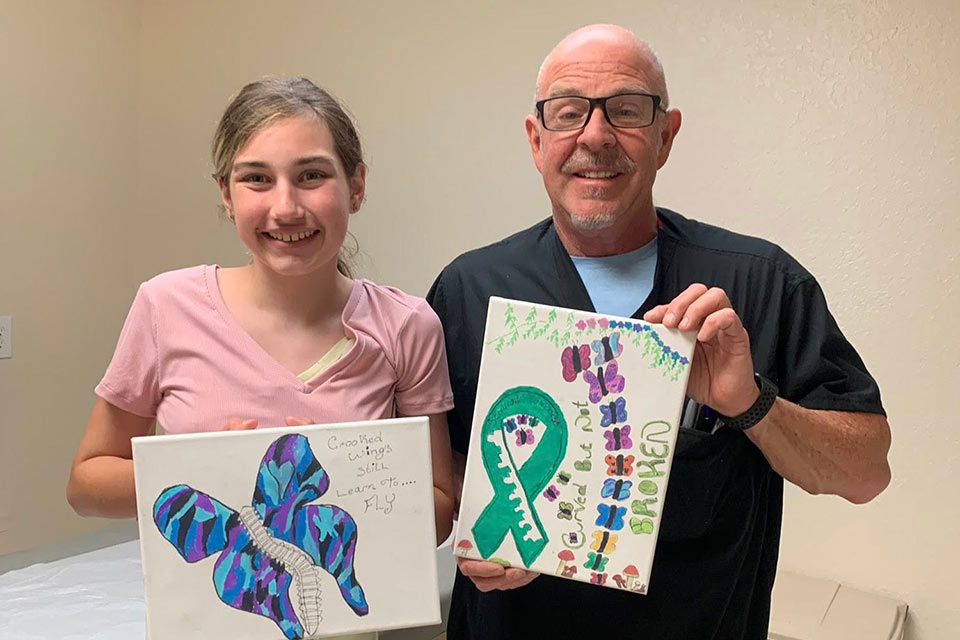Carla, Carlota's Mother:
Well, the story of Carlota starts in a very nice and beautiful way because I wanted to wait to have another child until my first was old enough to be independent. So I waited seven years and a half and we were expecting Carlota.
Tata, Carlota's Grandmother:
[in Spanish 0:27 – 1:00]
Carla:
Carlota was a baby that needed a lot of stuff. She was crying from start to the end. I told the doctor, Please make her all the exams necessary to know that everything is correct. He told me like, Okay, Carla, you were right. Carlotta has a brain palsy. He told the name that now it's easy for me to say my name. It's Emi Paredes, espastic, spastic, hemiparesic.
Carlos Armando Velasco-Hildago, MD, Orthopaedic Surgeon at Shriners Children's Mexico:
[in Spanish 1:37 – 2:30]
Carlota:
In Shriners, they treat you the best way possible. All the attention, the help, the medical feedback, it's amazing. You wouldn't get that anywhere else. Every single person there, they make you love yourself more.
Carla:
To be blessed to have Carlotta as my daughter has inspired my life because nothing has been easy. But we've been there to support each other for the good for the bads.
Carlota:
I'm really proud of myself. I feel confident. I feel strong. I feel capable of showing the world what I want to show. I'm looking forward to being an Olympic champion and the best international patient ambassador that they have had in Shriners's history.
Kathleen, Brandon's Mother:
Brandon was a healthy, active six-year-old boy. In fact, he had just finished playing his last baseball game of the season, and we had noticed he had a little dribble, so maybe start of a cold or something. By Tuesday, his teacher mentioned that he had had a really bad headache, and Wednesday, he He woke up with a fever. So, of course, kept him home from school that day. Thursday, things were just progressing. You could tell he just wasn't feeling great. Saturday morning, Brandon woke up, and I was downstairs. We heard a loud bump.
Brian, Brandon's Father:
I ran into his room, and he told me he couldn't move his arm, and he couldn't move his leg. And I scooped him up.
At that point, we did take him, and I remember carrying him into the emergency room and telling him what was going on, and just the complete feeling of helplessness.
Dan A. Zlotolow, MD, Pediatric Orthopaedic Surgeon at Shriners Children's Philadelphia:
Acute flacid myelitis is what he has, or we call it AFM. It's basically the new polio. It was 2014 when AFM really made its debut. Brandon, he was the second year of acute flacid myelitis that we saw in the US.
Keith K. Gettys, MD, Pediatric Orthopaedic Surgeon at Shriners Children's Greenville:
Acute flacid myelitis, which can mean that you have some weakness and you lose the ability of some of your nerves to work. It primarily affected his lower extremities and his upper one arm. He's received lots of treatment for that at various trines along the way, lots of therapy.
Brandon:
The hardest thing I've ever done was learning to walk again, not only physically, but also mentally. It was one of the hardest, yet most rewarding things. As a six-year-old, it was a really big thing to be able to just even do something as simple as walk.
Brian:
One of the OTs shared with us about some of the new developments that Dr. Z and Dr. Cozen were doing in Shriners in Philadelphia.
Brandon:
Before the surgery, I had zero function in my arm, and I couldn't do anything with it. I can now do a bicep curl, and I can function and eat almost like normal.
Dr. Zlotolow:
I think Shriners occupies a very special place in the medical system.We have become the center for acute flacid myelitis in the world. It just shows you how if you have the right resources, you can tackle really difficult problems that other people are not able to tackle.
Brandon:
I've never been anywhere that I feel the same way I do at Shriners. Everybody knows you. Everybody is doing their absolute best to make sure that you to get what you need, and that is one of the greatest feelings.













